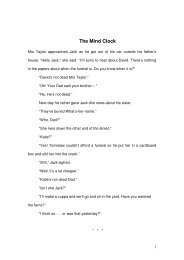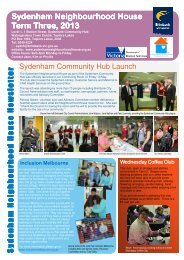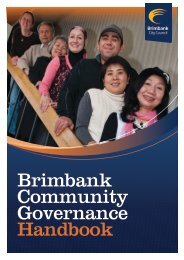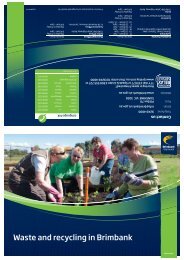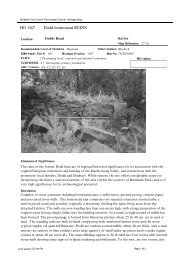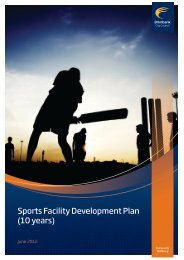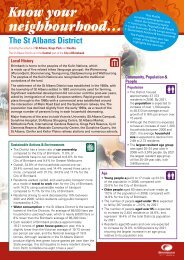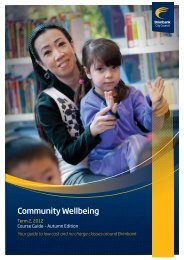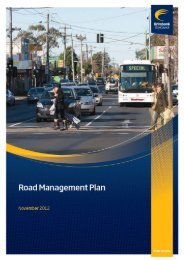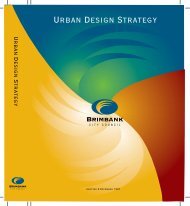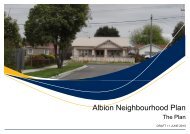The Diverse Communities of Brimbank Profile - Brimbank City Council
The Diverse Communities of Brimbank Profile - Brimbank City Council
The Diverse Communities of Brimbank Profile - Brimbank City Council
Create successful ePaper yourself
Turn your PDF publications into a flip-book with our unique Google optimized e-Paper software.
Popuation Demographics<br />
One parent families<br />
• 10.6% <strong>of</strong> families living in <strong>Brimbank</strong><br />
were single parent families with at<br />
least one child under 15, which was<br />
higher than the Melbourne average<br />
(7.5%). 2<br />
• Between 2001 and 2006, the<br />
number <strong>of</strong> one parent families<br />
increased by over 1,700. <strong>The</strong> highest<br />
proportion <strong>of</strong> one parent families<br />
live in the suburb <strong>of</strong> St Albans<br />
(24%), increasing significantly<br />
between 2001 and 2006. <strong>The</strong> largest<br />
increases <strong>of</strong> one parent families<br />
were in the suburbs <strong>of</strong> Sunshine<br />
West and Albanvale. <strong>The</strong>re is a clear<br />
trend towards growth <strong>of</strong> one parent<br />
families in the lower socio-economic<br />
southern suburbs <strong>of</strong> <strong>Brimbank</strong>.<br />
However the more affluent northern<br />
suburbs <strong>of</strong> <strong>Brimbank</strong> also had large<br />
increases, e.g. Taylors Lakes and<br />
Sydenham, where the numbers<br />
nearly doubled between 2001 and<br />
2006. 2<br />
• About 85% <strong>of</strong> single parents in<br />
<strong>Brimbank</strong> are female, which is close<br />
to the Melbourne average. 2<br />
Percentage<br />
Age distribution <strong>of</strong> lone parents in <strong>Brimbank</strong> and Greater Melbourne, 2006<br />
20<br />
15<br />
10<br />
5<br />
0<br />
15–19<br />
20–24<br />
25–29<br />
30–34<br />
35–39 40–44 45–49<br />
Age (years)<br />
One parent families with children under 15 years, <strong>City</strong> <strong>of</strong> <strong>Brimbank</strong> 2006<br />
(as a percentage <strong>of</strong> total families)<br />
• Lone parents in <strong>Brimbank</strong> tend<br />
to be younger, and particularly<br />
clustered in their early 30s. <strong>The</strong><br />
number <strong>of</strong> younger lone parents<br />
living in <strong>Brimbank</strong> is around double<br />
the Melbourne average (described <strong>Brimbank</strong> in<br />
the below graph). 2<br />
50–54<br />
55–59<br />
60–64<br />
Melbourne SD<br />
Melbourne SD<br />
<strong>Brimbank</strong><br />
65+<br />
Lone person households<br />
• <strong>Brimbank</strong> currently has a smaller<br />
proportion <strong>of</strong> residents living in lone<br />
person households than Greater<br />
Melbourne (16.7% compared<br />
to 22.7%). 2 Although by 2021,<br />
lone person’s households are<br />
expected to increase to 19.2% <strong>of</strong> all<br />
households. 3<br />
• Between 2001 and 2006’ couples<br />
without children and lone person<br />
households increased dramatically.<br />
Most <strong>of</strong> these households were<br />
empty nesters and older lone<br />
persons, although in some areas<br />
(such as Sunshine) lone person<br />
households were more <strong>of</strong>ten<br />
younger people living alone. 2<br />
14



